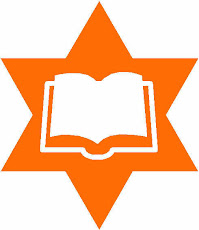First of all, a couple of corrections: Three of the eight participants were already teaching before the class began. An additional one had a job lined up for the fall. Two were considering career changes (into education) and thought this would be a way to gain information on the way to making an informed decision. The remaining two participants were interested in the topic – had not decided whether they were going to teach in congregational/supplemental schools or not.
So, how’d it go? Overall, really well – with one big “fumph” in the middle (more about that later).
My colleague and I had decided to be as interactive in our teaching as possible – our goal was to model the “how-to” as well as share the content information.
We began with a session on Mind-Mapping, as a “getting to know you” activity. After they explained their maps, we posted them in the room each time we met. I’m going to introduce this technique in a class for teens I’m teaching this fall!
Our next activity asked them to take a quiz to determine where they fell on the list of multiple intelligences – and then to work with a partner to suggest an auditory, visual, and kinesthetic activity they could incorporate in a lesson to teach a topic of their choice. The quiz was “okay” – next time we might ask them to select from a variety of activities those that are most attractive to them and get at the MI approach in that way. The A-V-K activity was enjoyable – and productive. Just need a larger board to write their responses on.
My colleague does this wonderful piece on introducing the concept of “Big Ideas,” which he defines as an over-arching idea that will guide your teaching for the year. It provides a focus, and helps ensure that activities that you choose for the class to engage in are chosen because they support the “Big Idea” – not just because they are “fun to do.” He provided a couple of different scenarios and had the participants determine a) whether there was a big idea that was apparent to them; and b) whether the activities supported the big idea. Fascinating conversation – I’m always thrilled when students see something in the material that I haven’t seen. This activity got high marks from the class. When I plan for my fall class, I’ll need to specifically articulate a “Big Idea” – what will be guiding my teaching; what do I want them to learn; what’s the relevance?
Classroom middot/values and their effect on establishing a learning environment that’s safe and respectful for all was next on the list. I could tell it was a “new” topic for many of them, not surprisingly. Many new teachers – as well as many with a lot of experience – approach classroom management issues from a “discipline” [read “punishment and rewards”] perspective. That’s never worked really well for me. I’ve found instead that respect and safety, with a gentle insistence on those two characteristics, often get me results where I spend minimal time dealing with obnoxious behaviors. I shared with the class, the list of middot I’ve shared here, as well as my earlier post on Values-Based Decision Making. After we all talked about the values on the list, I handed out three dot stickers and asked them to “spend” their dots on the three middot that they felt were crucial in their classrooms-to-be. Feedback on that exercise was very positive, both that week and subsequently. Now I’m wondering how I can integrate this activity into my teen classroom this fall. I know I can use it in the teacher training workshops I’ll be doing. But in the classroom….? Not sure – comments/suggestions would be welcome here.
One evening I brought a wide variety of resource books in – many from the ARE “Teaching….” series (now available from Behrman House); some great new publications from Torah Aura (Active Jewish Learning is my new favorite, along with the Artzeinu Teacher’s Guide). They *LOVED* the chance to browse and pull out ideas. We’ll definitely do that again.
A final piece that worked really well – my typical four-question evaluation sheet distributed at the end of every class:
- What one thing did you learn during this session?
- What did you think worked particularly well?
- What needs to be improved next time?
- Other comments:
Not only did it help them begin the reflective process – it provided us with the necessary information when things didn’t go well….. More about that in my next posting!





No comments:
Post a Comment